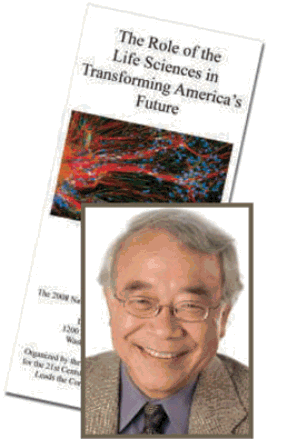|
|
|
|
|
|
|
News & Views item - February 2009 |
![]() Elias Zerhouni: The greatest risk in periods of tight economic times and
tight budgets is to stop taking risks. (February, 3 2009)
Elias Zerhouni: The greatest risk in periods of tight economic times and
tight budgets is to stop taking risks. (February, 3 2009)
The former U.S. National Institutes of Health Director, Elias Zerhouni, is quoted saying that the "greatest risk in periods of tight economic times and tight budgets is to stop taking risks" in the draft of a paper released on January 30 summarizing a workshop held on December 3 by the 2008 National Academies' Biology Summit on "The Role of the Life Sciences in Transforming America's Future"
One of the salient points stressed by Dr Zerhouni was the need to "create venture space". The peer-review system, although good at stopping weak science, he said, is "not very good" at identifying new ideas. He disparaged the "herd mentality" reflected in much NIH research.
Surely the drive by the current Australian government to introduce the Excellence in Research for Australia (ERA) does nothing except exacerbate that mentality.
The 31-page paper emphasises:
If current opportunities are grasped, the life sciences can help produce enough food for a growing population, cure chronic and acute diseases, meet future needs for energy, and manage the preservation of earth’s biological heritage for future generations.
 |
| Brainstorming. Keith Yamamoto
helped orchestrate a review of what's needed in basic life-sciences
research. CREDIT: THE NATIONAL ACADEMIES; PHOTO COURTESY OF UCSF |
“Just as the basic biomedical research in the future is not going to be done by the pharmaceutical companies, [oil companies and agribusinesses] aren't going to do the fundamental research in photosynthesis and plant development and plant hormones that is going to lay the groundwork for a future understanding of how plants work,” said Thomas Cech, President of the Howard Hughes Medical Institute. For the life sciences to have a dramatic effect on nutrition, the world’s food supply, and the renewable energy problem, “we need to keep reinvesting in understanding the biology.”
The evolution of life “put earth under new management,” James Collins said. Professor Collins is currently on leave from Arizona State University to serve as Assistant Director for Biological Sciences at the National Science Foundation. Understanding the future state of the planet will require understanding the biological systems that have shaped the planet.
“The generation of data is not equal to the generation of knowledge,” said Elias Zerhouni. Understanding the complexity inherent in organisms is another grand challenge that could inspire the best efforts of students and scientists.
“We have to encourage young people to take up this next challenge,” said Susan Hockfield President of the Massachusetts Institute of Technology. “[We need] to grab the attention of kids from K to 12 to say, ‘wow, this is cool stuff, I want to be doing science and engineering and math.'”
The full list of workshop participants in the one-day workshop is given below.
Ralph Cicerone, President of the National Academy of Sciences
James P. Collins Assistant Director for Biological Sciences, National Science Foundation
Raymond L. Orbach Undersecretary for Science in the United States Department of Energy
Thomas R. Cech President of the Howard Hughes Medical Institute
David T. Kingsbury Chief Program Officer for Science, Gordon and Betty Moore Foundation
Susan Hockfield President of the Massachusetts Institute of Technology
Susan Desmond-Hellmann President of Product Development, Genentech
Harold Varmus President of the Memorial Sloan-Kettering Cancer Center
Cynthia Kenyon American Cancer Society Professor, UCSF
Lucy Shapiro Ludwig Professor of Cancer Research, Stanford University
Robert Fraley Executive Vice President and Chief Technology Officer, Monsanto
Elias A. Zerhouni former Director of the National Institutes of Health
Keith Yamamoto Chairman, Board on Life Sciences, National Research Council
The summary of conclusions reached by the attendees:
One hundred years ago, the airplane and the tungsten filament light bulb
were five-year-old inventions. “No one could have predicted where those
inventions would have taken us,” said Keith Yamamoto.
Today the life sciences are in a comparable position. It is impossible to predict what new technologies and new industries will arise from today’s basic research. What can be predicted is that the world will undergo dramatic changes in the next one hundred years, and that the life sciences can help ensure that those changes produce a better life for people everywhere.
While the potential for significant advances is enormous, many challenges need
to be to overcome. Achieving the promise of the life sciences articulated by the
Summit speakers will require investment, creative approaches to how life
sciences research is organized and funded, and attention to improving science
education at all levels.
The Summit demonstrated that many of the ingredients for success are already in place. Many policy-makers, university officials, and scientists have begun to implement the changes that will allow the life sciences to transform America’s -- and the world’s -- future. Expanding these initiatives to a broader set of funding agencies, universities, and industrial entities will help ensure that the 21st century will be, as many have predicted, the century of biology.